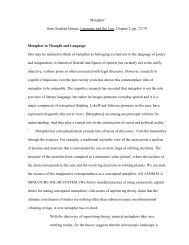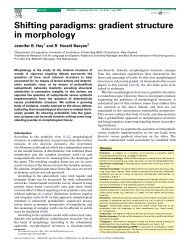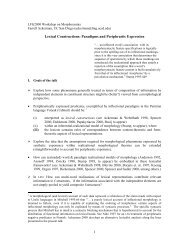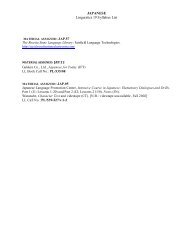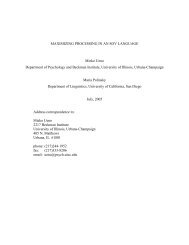Affricating ejective fricatives: The case of Tigrinya - Linguistics
Affricating ejective fricatives: The case of Tigrinya - Linguistics
Affricating ejective fricatives: The case of Tigrinya - Linguistics
Create successful ePaper yourself
Turn your PDF publications into a flip-book with our unique Google optimized e-Paper software.
<strong>Affricating</strong> <strong>ejective</strong> <strong>fricatives</strong>: <strong>The</strong> <strong>case</strong> <strong>of</strong> <strong>Tigrinya</strong> 59aerodynamic evidence in the related language Amharic (Demolin 2002, 2004). We do not,however, present conclusive physiological evidence for the realization <strong>of</strong> <strong>Tigrinya</strong> /s’/ as [ts’].Affricate closure duration is on average 25 ms (50%) longer than <strong>ejective</strong> fricative closure,a statistically significant difference that may (in addition to place <strong>of</strong> articulation differences)help distinguish /s’/ from /’/ or at least prevent /s’/ from undergoing reanalysis as /ts’/.As predicted, closure duration differentiates phonological length for the <strong>ejective</strong> <strong>fricatives</strong>/s˘’/ and /s’/ (by about 13 ms). Closure duration also distinguishes geminate and singletonaffricates by a margin <strong>of</strong> approximately 14 ms (see Table 5 above). <strong>The</strong> geminate <strong>ejective</strong>fricative /s˘’/ was significantly more likely than the singleton <strong>ejective</strong> fricative /s’/ to manifestclosure. We find that when closure is present geminate /s˘’/ is realized as [t˘s’], i.e. with alonger silent interval than the realization <strong>of</strong> singleton /s’/ → [ts’]. This is reminiscent <strong>of</strong>findings by Pycha (2009: 21), who argues that among Hungarian affricates ‘phonologicallengthening exclusively increases closure duration’ rather than release duration. To the extentthat pre-release closure is associated with the phonological length <strong>of</strong> affricates (and ourfindings show that it is), we suggest that <strong>Tigrinya</strong>’s <strong>ejective</strong> fricative, when accompanied byclosure, is phonologically similar to an affricate.For <strong>fricatives</strong>, pulmonic release is significantly longer than <strong>ejective</strong> release. <strong>The</strong> period<strong>of</strong> frication is 101 ms (110%) longer for pulmonic geminates and 34 ms (37%) longer forpulmonic singletons. This observation was expected and is supported by similar findings forAmharic (Demolin 2002, 2004) and Kabardian (Gordon & Applebaum 2006). <strong>The</strong> effect hasbeen attributed to the limited volume <strong>of</strong> air available between the glottis and supralaryngealconstriction for the <strong>ejective</strong> fricative. By contrast, pulmonic <strong>fricatives</strong> have access to a muchlarger volume <strong>of</strong> air contained in the lungs. Relatively high airflows are more sustainableduring pulmonic <strong>fricatives</strong> (Maddieson 1997, Maddieson et al. 2001). Further aerodynamicresearch could shed light on this issue.Release duration does not appear to signal phonological length among <strong>ejective</strong> <strong>fricatives</strong>.This result is intriguing, since release duration does distinguish geminate pulmonic <strong>fricatives</strong>from singleton pulmonic <strong>fricatives</strong> in <strong>Tigrinya</strong> as well as other languages, e.g. Swedish(Löfqvist 2005). Instead <strong>of</strong> release duration, it is closure duration that signals phonologicallength among <strong>Tigrinya</strong> <strong>ejective</strong> <strong>fricatives</strong>, much as it does for affricates in Hungarian (Pycha2009). Release duration is not a significant cue for phonological length even among the subset<strong>of</strong> <strong>ejective</strong> <strong>fricatives</strong> that lack closure.While our findings show that affrication occurs in a majority <strong>of</strong> <strong>ejective</strong> <strong>fricatives</strong>, thisleaves a minority <strong>of</strong> <strong>ejective</strong> <strong>fricatives</strong> that are crucially not distinguished by closure beforerelease. <strong>The</strong>se tokens provide a window to acoustic cues (besides closure) that may signalejectivity among <strong>fricatives</strong>, and also allow us to compare differences between [s’] and [ts’],both surface realizations <strong>of</strong> <strong>Tigrinya</strong>’s <strong>ejective</strong> fricative /s’/. Release duration is one suchacoustic cue, and pulmonic <strong>fricatives</strong> do still have longer release duration than <strong>ejective</strong>fricative tokens with no closure. However, release duration still contributes relatively little, ifanything, to the phonological length distinction among <strong>ejective</strong> <strong>fricatives</strong>, even for the <strong>case</strong>swith no closure. This leads us to speculate that phonological length may be neutralized when<strong>ejective</strong> fricative closure is lost.Laryngealization duration, or the amount <strong>of</strong> time it takes for regular vocal fold vibrationto initiate after release, is significantly greater for <strong>ejective</strong> <strong>fricatives</strong> in relation to pulmonics,a characteristic also observed for other languages with <strong>ejective</strong> <strong>fricatives</strong>. This most likelystems from the increased time it takes for the larynx to lower from its elevated positionand/or for the appropriate pressure differential across the glottis to be reached, thus givingrise to modal voicing. Fre Woldu (1985) demonstrates that this period <strong>of</strong> relative silence isthe weightiest psychoacoustic cue in distinguishing pulmonic and <strong>ejective</strong> stops.A considerable amount <strong>of</strong> variation has been reported in the VOT (voice onset time) <strong>of</strong><strong>ejective</strong> stops. VOTs with an average <strong>of</strong> 12 ms have been reported in Abkhaz (Catford 1983)while a mean VOT <strong>of</strong> 108 ms (SD = 31) has been reported for coronal <strong>ejective</strong> stops inNavajo (McDonough & Ladefoged 1993: 154). Our results show that the average post-release







